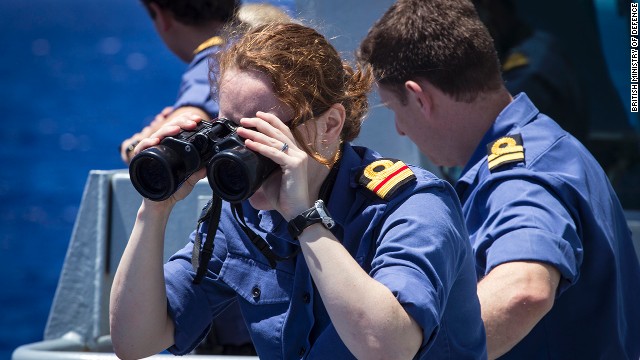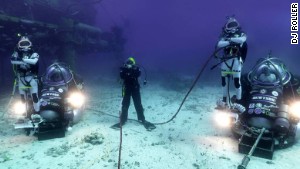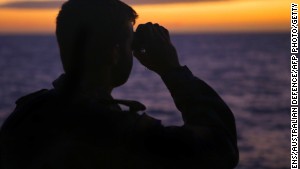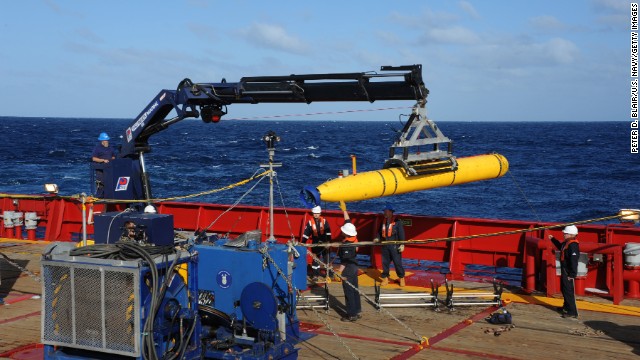April 14, 2014 -- Updated 0932 GMT (1732 HKT)
STORY HIGHLIGHTS
- An oil slick has been found 5.5 kilometers (3.4 miles) from where pings were detected
- The Bluefin-21 underwater vehicle is expected to be deployed Monday
- It replaces the towed pinger locator because no pings have been detected in six days
- Search official: There's no guarantee the the underwater vehicle will find wreckage
(CNN) -- With no underwater pulses detected in almost a week, Australian authorities said Monday they will stop listening for pings coming from the floor of the Indian Ocean -- and will now deploy an underwater vehicle.
"We haven't had a single detection in six days," Australian chief search coordinator Angus Houston said. "It's time to go underwater."
The Bluefin-21 vehicle was expected to be deployed around 5 p.m. Perth time (5 a.m. ET) Monday, the U.S. Navy said. The device is owned by the U.S. Navy.
It's a probe equipped with side-scan sonar -- acoustic technology that creates pictures from the reflections of sound rather than light.
Though the discovery of four pings believed to be from the jet's so-called black boxes -- its flight data recorder and its cockpit voice recorder -- have helped investigators narrow the search area, they would still face a formidable task.
Houston cautioned against hopes that the underwater vehicle will find wreckage.




"It may not," he said. "This will be a slow and painstaking process."
Each deployment will last 24 hours.
It will take two hours for the Bluefin-21 to get down to the bottom of the ocean. Then it will scour the ocean bed for 16 hours, and take another two hours to resurface. It will take take another four hours to download and analyze the data collected, Houston said.
The first mission will cover an area 5 kilometers by 8 kilometers (3.1 miles by 4.9 miles).
The bottom of the search area is not sharply mountainous -- it's more flat and almost rolling, Houston said. But he said the area likely has a lot of silt on the bottom, which can "complicate" the search.
The Bluefin will take anywhere from six weeks to two months to scan the entire search area.
Oil slick found
While the pings have sputtered out, officials might have a new clue they're searching in the right area.
The Australian ship Ocean Shield detected an oil slick Sunday evening, but it is unclear where the oil came from.
A 2-liter sample has been collected for examination, but it will take a few days.
"I stress the source of the oil has yet to be determined, but the oil slick is approximately 5,500 meters (3.4 miles) downwind ... from the vicinity of the detections of the TPL on Ocean Shield," Houston said, referring to the pings detected by the towed pinger locator.
The news comes after a weekend of notable developments in the search for MH370, which disappeared March 8 with 239 people on board. Monday marks Day 38 of the search.
Batteries likely dead
The batteries powering the locator beacons inside the so-called black boxes are probably dead, a top official from the company that manufactures the beacons told CNN on Sunday. They were certified to last 30 days, a deadline that's already passed.

That means searchers may not be able to detect any more pings to help lead them to those pieces of the missing plane.
"More than likely they are reaching end of life or already have. If (a beacon) is still going, it is very, very quiet at this point," Jeff Densmore told CNN's "State of the Union with Candy Crowley" on Sunday.
The time is ripe to move on to other search techniques.
"Every good effort has been expended, but it's now looking like the batteries are failing, and it's time to start mowing the lawn, as we say, time to start scanning the sea floor," said Rob McCollum, a CNN analyst and ocean search specialist.
Search area widens, shrinks
After days of whittling down the search area in the Indian Ocean, officials expanded the target zone by 40% from Saturday to Sunday.
While that may seem like a setback in the investigation, it might not be, said Mary Schiavo, a former inspector general for the U.S. Department of Transportation.
"What I think they're doing is giving one last final push, a last-ditch effort if you will, to see if by any chance there is any wreckage to be found," she said. "Because even a few pieces would help narrow the search. I think it's one last big push. Maybe just a Hail Mary pass to try and find anything that they can to help them zero in on where to go on the ocean floor."
Monday's search area decreased by 17%. Twelve aircraft and 15 ships were participating in the hunt over an 18,400-square-mile (47,600-square-kilomter) area.
"The air and surface search for floating material will be completed in the next two to three days in the area where the aircraft most likely entered the water," Houston said.
Catherine Tamoh Lion, the mother of the missing plane's chief steward Andrew Nari, said the news that no more pings have been heard is upsetting.
"Our sadness is now just prolonged," she told CNN.
"I feel like they are somewhere," she said of the passengers. "I don't know where. Just praying to God. Miracles can happen. "



No comments:
Post a Comment